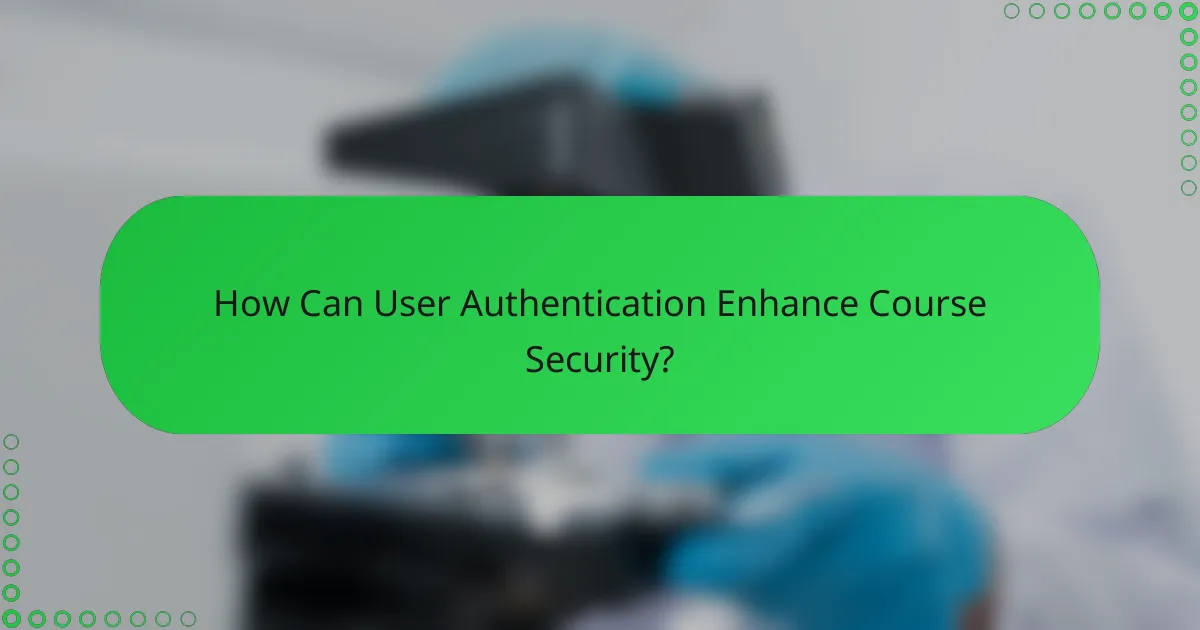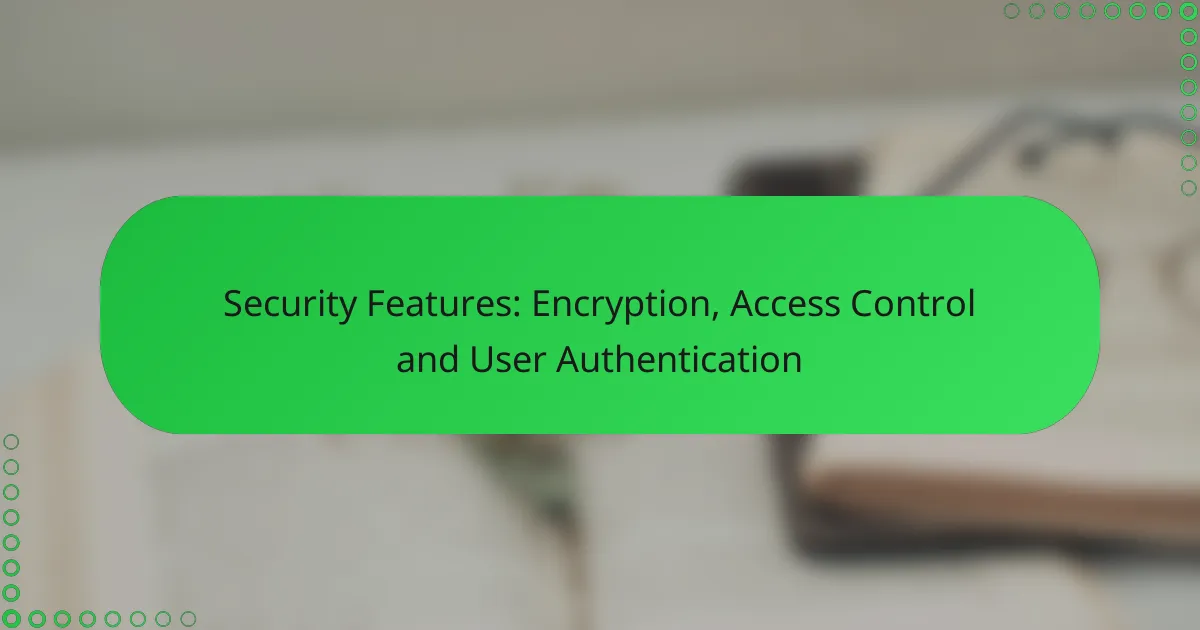In the realm of online courses, robust security features such as encryption, access control, and user authentication are essential for safeguarding sensitive information. For instance, understanding Cloud Gaming Security and Privacy can provide insights into how encryption transforms data into a secure format, protecting personal and payment details from unauthorized access. Meanwhile, effective access control mechanisms ensure that only authorized users can access specific resources, enhancing both security and the overall user experience.

What Are the Key Security Features for Online Courses?
The key security features for online courses include encryption, access control, and user authentication. These elements work together to protect sensitive information, ensure only authorized users can access content, and verify user identities.
Encryption
Encryption is the process of converting data into a coded format to prevent unauthorized access. For online courses, this means securing sensitive information such as personal details and payment data using protocols like SSL/TLS. Implementing strong encryption standards helps protect data both in transit and at rest.
When selecting an encryption method, consider using AES (Advanced Encryption Standard) with a key size of at least 256 bits for robust security. Regularly updating encryption protocols is crucial to safeguard against emerging threats.
Access Control
Access control determines who can view or interact with course materials and user data. Implementing role-based access control (RBAC) allows administrators to assign permissions based on user roles, ensuring that only authorized personnel can access sensitive information.
It’s essential to regularly review and update access permissions, especially when users change roles or leave the organization. Employing multi-factor authentication (MFA) can further enhance access security by requiring additional verification steps.
User Authentication
User authentication verifies the identity of individuals attempting to access online courses. Common methods include usernames and passwords, but stronger options like biometric authentication or social login can provide additional security layers.
Encourage users to create strong passwords and consider implementing password policies that require regular updates. Using MFA can significantly reduce the risk of unauthorized access by combining something the user knows (password) with something they have (a mobile device).
Data Integrity
Data integrity ensures that information remains accurate and unaltered during storage and transmission. Techniques such as checksums and hashes can help verify that data has not been tampered with or corrupted.
Regular audits of data integrity can help identify potential issues early. Employing version control systems can also assist in tracking changes and maintaining accurate records of course materials.
Compliance Standards
Compliance standards are regulations that online courses must adhere to in order to protect user data. Common standards include GDPR in Europe and FERPA in the United States, which govern data privacy and security.
Staying compliant requires regular training for staff on data protection practices and periodic assessments of security measures. Familiarizing yourself with relevant regulations is crucial to avoid legal penalties and maintain user trust.

How Does Encryption Protect Online Course Data?
Encryption safeguards online course data by converting it into a coded format that is unreadable without the appropriate decryption key. This process ensures that sensitive information, such as personal details and payment information, remains confidential and secure from unauthorized access.
Symmetric Encryption
Symmetric encryption uses a single key for both encryption and decryption, making it efficient for processing large amounts of data. However, the key must be securely shared between the parties involved, which can pose risks if not managed properly. Common symmetric algorithms include AES and DES, which are widely used for securing online transactions.
When implementing symmetric encryption, ensure that the key is complex and changed regularly to enhance security. Avoid sharing the key over unsecured channels to minimize the risk of interception.
Asymmetric Encryption
Asymmetric encryption employs a pair of keys: a public key for encryption and a private key for decryption. This method eliminates the need to share a secret key, significantly enhancing security. RSA and ECC are popular asymmetric algorithms used in secure communications, such as SSL/TLS for online courses.
While asymmetric encryption is more secure, it is also slower than symmetric encryption. It is often used to securely exchange symmetric keys, combining the strengths of both methods for optimal security in online environments.
Encryption Protocols
Encryption protocols define the rules and methods for encrypting data during transmission. Common protocols include SSL/TLS for secure web communications and HTTPS for secure browsing, which are essential for protecting online course data. These protocols ensure that data remains confidential and integral while being transferred over the internet.
When selecting encryption protocols, consider their compatibility with your platform and the level of security they provide. Regularly update your protocols to comply with the latest security standards and protect against emerging threats.

What Access Control Methods Are Effective for Course Platforms?
Effective access control methods for course platforms ensure that only authorized users can access specific resources. These methods help manage permissions based on user roles, attributes, or predefined lists, enhancing security and user experience.
Role-Based Access Control (RBAC)
Role-Based Access Control (RBAC) assigns permissions based on user roles within the course platform. For example, instructors may have access to course materials and grading tools, while students can only view content and submit assignments. This method simplifies management by grouping users with similar responsibilities.
When implementing RBAC, it’s essential to define clear roles and regularly review them to ensure they align with organizational needs. Avoid creating too many roles, as this can complicate management and lead to security vulnerabilities.
Attribute-Based Access Control (ABAC)
Attribute-Based Access Control (ABAC) grants access based on user attributes, resource characteristics, and environmental conditions. For instance, a student might gain access to certain materials only if they have completed prerequisite courses or are enrolled in a specific program. This method offers flexibility and granularity in access management.
To effectively use ABAC, establish a comprehensive set of attributes and rules that govern access. Be cautious of complexity; overly intricate rules can lead to confusion and potential security gaps. Regularly audit these attributes to maintain relevance.
Access Control Lists (ACLs)
Access Control Lists (ACLs) specify which users or groups have access to particular resources and what actions they can perform. For example, an ACL might allow only certain users to edit course content while granting others read-only access. This method is straightforward but can become cumbersome with many resources and users.
When using ACLs, keep the lists manageable and regularly update them to reflect changes in user roles or course offerings. Avoid overly broad permissions that could expose sensitive information. A periodic review of ACLs can help maintain security and compliance with regulations.

How Can User Authentication Enhance Course Security?
User authentication significantly enhances course security by ensuring that only authorized individuals can access sensitive materials and information. Implementing robust authentication methods helps protect against unauthorized access, data breaches, and identity theft.
Two-Factor Authentication (2FA)
Two-Factor Authentication (2FA) adds an extra layer of security by requiring users to provide two forms of identification before accessing their accounts. Typically, this involves something the user knows (like a password) and something the user has (such as a mobile device for receiving a one-time code).
Implementing 2FA can reduce the risk of unauthorized access by up to 99%. Popular methods include SMS codes, authentication apps, or hardware tokens. However, users should be aware that SMS-based 2FA can be vulnerable to interception.
Single Sign-On (SSO)
Single Sign-On (SSO) allows users to access multiple applications with one set of login credentials, simplifying the user experience while maintaining security. This method reduces password fatigue, which can lead to weaker passwords or password reuse across different platforms.
While SSO enhances convenience, it is crucial to ensure that the SSO provider implements strong security measures. Organizations should regularly review and update their SSO policies to mitigate risks associated with centralized access points.
Biometric Authentication
Biometric authentication uses unique physical characteristics, such as fingerprints, facial recognition, or iris scans, to verify a user’s identity. This method is increasingly popular due to its convenience and difficulty to replicate.
While biometric systems can enhance security, they also raise privacy concerns and require careful handling of biometric data to comply with regulations like GDPR. Organizations should consider the balance between user convenience and the potential risks associated with storing biometric information.

What Are the Best Practices for Implementing Security Features?
Best practices for implementing security features like encryption, access control, and user authentication include regular assessments, adherence to established standards, and a proactive approach to potential vulnerabilities. Organizations should prioritize a layered security strategy to effectively protect sensitive data.
Regular Security Audits
Conducting regular security audits is essential for identifying weaknesses in your security features. These audits should evaluate encryption methods, access control measures, and user authentication processes to ensure they meet current security standards and best practices.
Audits can be performed internally or by third-party experts. A typical schedule might involve annual comprehensive audits, with more frequent reviews of critical systems, such as quarterly checks. This helps organizations stay ahead of potential threats and compliance requirements.
When planning audits, consider creating a checklist that includes key areas such as data encryption effectiveness, user access logs, and authentication protocols. This structured approach can help ensure thorough evaluations and facilitate improvements where necessary.
